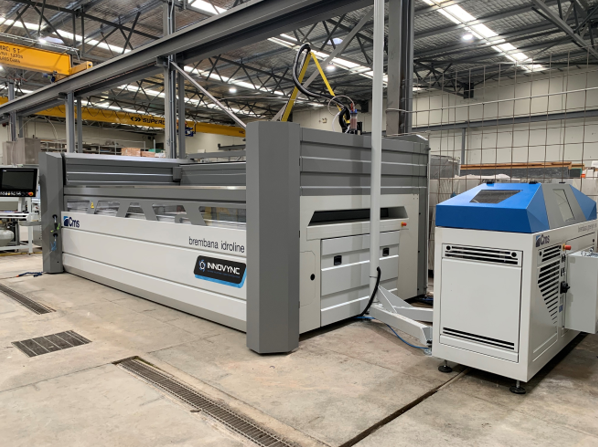When sintered stone first entered the market, architects, designers, and stonemasons excitedly rushed to explore its potential. At last, they had a material that was hard, heat-proof, stain and UV-resistant – and available in a wide range of colours. The only problem? Sintered stone is not easy to cut.
Saw blades, tools and techniques that worked so well on natural and engineered stone cause porcelain slabs, Dekton, and other ultra-compact surfaces to crack and break. As a result, many fabricators have banished it from their workshops, ridding themselves of a headache – and a potentially lucrative new market. Others, like European Ceramics, planted the seeds for a fruitful future; expecting greater growth in years to come.
“Porcelain slabs are growing in every market worldwide. Today, we see many companies bringing out their own range of porcelain slabs. When we first started with porcelain slabs, we only had one factory and supply chain, and it was certainly a bold move to invest in the industry,” says David Serra, second-generation Director of the Perth-based firm.
Everywhere you look, porcelain, Dekton and sintered stone is on the rise. Architects love it for its looks, versatility, and consistency; allowing them to create trendy kitchens and outdoor spaces. The only trouble is finding a fabricator who is willing to carry out their projects.
For many manufacturers, cutting sintered material causes such a headache that they will do everything they can to get out of it. One single crack and a whole slab could be ruined, costing the business dearly. That thought alone has fabricators nervous about taking on Dekton and porcelain jobs – especially if they don’t have the equipment or labour to ensure that quality products are consistently produced.
“Using traditional methods like a bridge saw even with a special blade requires an experienced and skilled sawyer. We find that many manufacturers either reject jobs because they can’t handle it, or price themselves out of it; pricing for four or five slabs, instead of two as they assume that breakages will happen – which is unheard of,” says Dominik Holfter, Stone and Glass sales rep at Innovync.
The answer lies in having the right technology on board. Depending on the kind of jobs coming through, specialised machining centres could be used – especially if straight lines are being cut. But there is a much safer, more versatile alternative that is perfectly suited to cutting brittle materials – and its value is becoming more and more apparent in the industry.
“Only recently did the Stone industry decide to pick up on water jets and incorporate them into the machinery toolkit. The way the waterjet cuts, it’s a gentler process on the stone, because the pressure is so concentrated on the cut – rather than having downwards and sideways pressure as from a bridge saw,” explains Dominik.
Models from world-renowned Italian brand CMS, which Innovync carries, are especially easy to work with. Equipped with a highly detailed materials database that allows for plug-and-play setup, plus fine-tuned controls, quality results consistently emerge.
“Once you program the job and tell the machine what to do, you can cut – there are no physical parameters required. It’s all on the machine, taking responsibility from the operator. You can probably cut faster on a bridge saw, and it’s a little cheaper to run it, but you need to have a skilled operator to run it. But, unless you have an operator that knows how to listen to a saw and knows when to speed it down or up, you will run into problems,” Dominik remarks.
With massive skilled labour shortages sweeping across the industry, it is becoming even more difficult to find an operator who can reliably run Dekton and other sintered stone through a bridge saw. David and his team are leaders in the space, and run workshops all over the world, teaching operators how to work with such materials using CNC machines. Despite decades of expertise, they too, know how difficult it is to find a suitable operator, right off the bat.
“Finding the right operator is very difficult as the new stonemason needs a high level of both physical and digital expertise. From our past experience, it could take several months or even years to fully train a person to work with porcelain slabs,” says the Director.
Those who dare to work with sintered stone tend to prefer the safety and security of waterjets – of which CMS has become leaders in. Coming out with their first Stone models in the 1980s, the equipment manufacturer has earned a reputation for reliability, efficiency, and quality. These traits don’t go unnoticed by innovators in the industry.
“We have used CMS machines from the beginning. Being of Italian origins, construction, design and manufacturing have always been my passion.
CMS – ‘Made in Italy’ is a no brainer and the fact that, in the 1980s, they were the first manufacturer of a Stone machining centre was a simple reason to invest and purchase CMS Stone machines. Today in our factory, we operate the CMS Idroline waterjet and Maxima CNC. Both machines serve us very well in the manufacturing of large porcelain slabs,” says David.
The beauty of waterjet machines is that they are versatile. Whether or not you decide to cut porcelain on them or prefer to stick with natural and engineered stone, they won’t sit unused in your factory. Just imagine what that means for a rapidly changing market, where demand for new materials is rising. Dekton is only the beginning.

